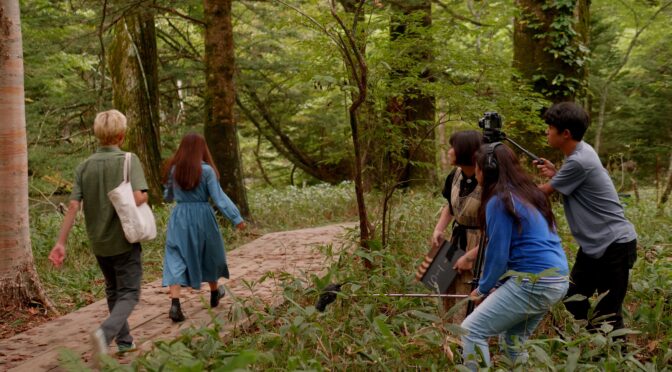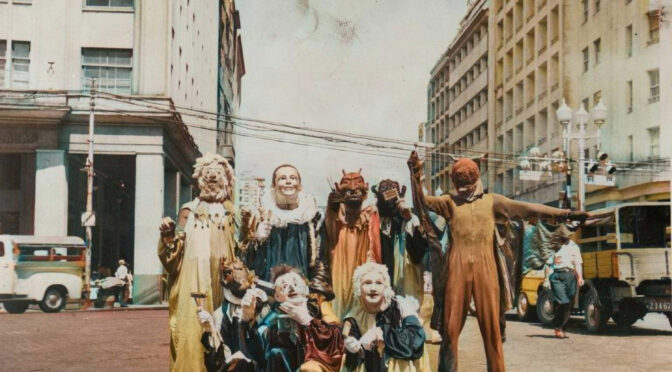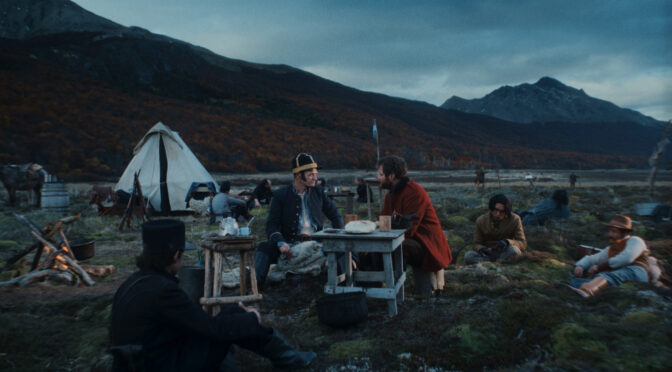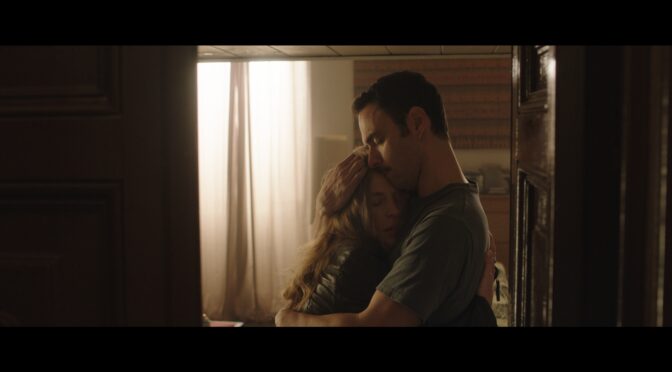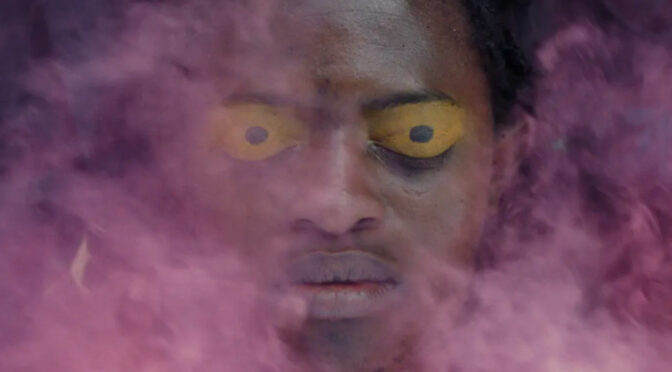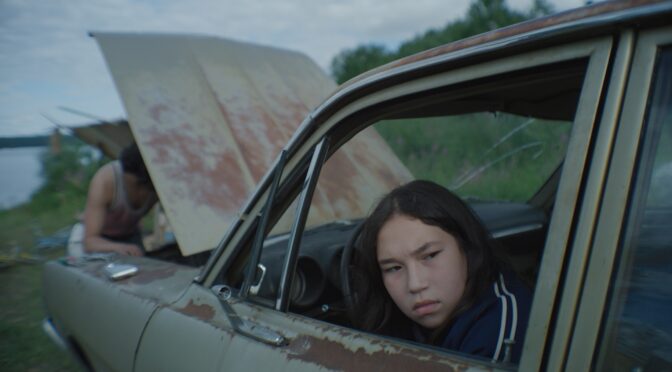Nel Labanof di Milano, il Laboratorio di Antropologia e Odontologia Forense dell’Università degli Studi, la professoressa Cristina Cattaneo si prende cura dei cadaveri senza identità, che lei stessa chiama “sconosciuti puri”. Sono questi stessi cadaveri a dare il nome al documentario di Valentina Cicogna e Mattia Colombo, Sconosciuti puri dedicato alle battaglie lavorative dell’antropologa forense.
Continua la lettura di “Sconosciuti puri” di Valentina Cicogna, Mattia ColomboArchivi tag: TFF41
“GRACE” BY ILYA POVOLOTSKY
Article by Antonio Congias
Translation by Eleonora Torrisi
The colossal shadow of wind turbines looms intermittently over Maria Lukyanova’s face, the protagonist of Grace, as if to recall the centrifugal rage by which she is invested.
She closes her eyelids and imagines an escape from the van in which she has lived for as long as she can remember and where her father (Gela Chitava), has placed his last hopes. A dwelling where father and daughter travel through Russia’s remote provinces, screening old films in villages where the internet has not yet taken over. For the protagonist, the escape from her father and consequently from their life as a nomad – or rather, as «travelers», as the man points out – materializes in the sea, which she can only dream about through the images of female swimmers in an old television set and in the plastic attractions of a water park inside a shopping mall.
“GRACE” DI ILYA POVOLOTSKY
L’ombra colossale delle pale eoliche incombe a intermittenza sul viso di Maria Lukyanova, protagonista di Grace, quasi a richiamare la rabbia centrifuga da cui è investita. Chiude le palpebre e immagina una via di fuga dal van in cui vive da quando ha memoria e dove il padre, Gela Chitava, ha riposto le sue ultime speranze. Una dimora con cui padre e figlia attraversano le province remote della Russia, proiettando vecchie pellicole nei villaggi in cui internet non ha ancora preso il sopravvento. L’evasione dal padre e di conseguenza dalla vita da nomade – o meglio, da «viaggiatori», come sottolinea il genitore – per la protagonista si materializza nel mare, che può solo sognare attraverso le immagini di nuotatrici in un vecchio televisore e le attrazioni plastiche di un parco acquatico all’interno di un centro commerciale.
Continua la lettura di “GRACE” DI ILYA POVOLOTSKY“RETAKE” BY KÔTA NAKANO
Article by Romeo Gjokaj
Translation by Sebastiano Liso
No man ever steps in the same river twice, for it’s not the same river and he’s not the same man. This idea, which can be traced back to the Heraclitean philosophy of Panta Rei, “everything flows,” well represents the meta-cinematic spirit of Retake, Japanese director Kôta Nakano’s debut. The film was presented at the Nuovimondi (“New Worlds”) section of the 41st Torino Film Festival.
Continua la lettura di “RETAKE” BY KÔTA NAKANO“RETAKE” DI KÔTA NAKANO
Nessun uomo entra due volte nello stesso fiume, perché non è lo stesso fiume e lui non è lo stesso uomo. Una simile idea, riconducibile alla filosofia eraclitea del panta rei, “tutto scorre”, ben rappresenta lo spirito meta-cinematografico di Retake, debutto assoluto per il regista giapponese Kôta Nakano e presentato alla sezione Nuovimondi della 41° edizione del Torino Film Festival.
Continua la lettura di “RETAKE” DI KÔTA NAKANO“RETRATROS FANTASMAS” di Kleber Mendonça Filho
Nel film di esordio di Kleber Mendonça Filho, Il suono intorno (O Som ao Redor, 2012), c’è una scena in cui due giovani visitano un cinema abbandonato e il sonoro evoca i film che in passato venivano proiettati in quella sala. Attraverso la dimensione sonora, le immagini si manifestano come spettri, echeggiando in spazi fatiscenti e dimenticati, per comunicare con i vivi. L’ultima opera del regista brasiliano, Retratos fantasmas – presentato nel Concorso Documentari Internazionali alla 41ª edizione del Torino Film Festival – si basa su questa stessa idea di ritorno delle immagini.
Continua la lettura di “RETRATROS FANTASMAS” di Kleber Mendonça Filho“RETRATROS FANTASMAS” by Kleber Mendonça Filho
Article by Fabio Bertolotto
Translation by Fabio Castagno
In Kleber Mendonça Filho’ debut film, O Som ao Redor (“Neighbouring sounds”, 2012), there’s a scene in which two people visit an abandoned cinema and the sound recalls films that used to be shown there in the past. Through this dimension, images manifest themselves as spectres that want to communicate with the living, echoing in crumbling and forgotten places. The last work of the Brazilian director, Retratos fantasmas (“Pictures of ghosts”) – presented at the International Documentaries Competition of the 41 st edition of the Torino Film Festival – is based on the same concept of returning images.
“PELIKAN BLUE” BY LÁSZLÓ CSÁKI
Article by Marco Di Pasquale
Translation by Carolina Criscuolo
It’s tough to picture what thousands of young people must have felt when, after years under the regime, they suddenly had the chance to cross their country’s borders and freely explore cities like London, Paris, Rome, Madrid, or Amsterdam. It’s not surprising that László Csáki wanted to create an animated documentary to leverage drawing possibilities and convey the feelings of an entire generation in Hungary during the 1990s, following the breakup of the People’s Republic and the Soviet Union.
Continua la lettura di “PELIKAN BLUE” BY LÁSZLÓ CSÁKI“PELIKAN BLUE” DI LÁSZLÓ CSÁKI
È difficile immaginare cosa possano aver provato migliaia di giovani che, dopo aver vissuto per anni sotto regime, un giorno, improvvisamente, hanno avuto la possibilità di varcare i confini del loro Paese e vedere liberamente Londra, Parigi, Roma, Madrid o Amsterdam. Non stupisce quindi che László Csáki abbia voluto fare un documentario in animazione per sfruttare le possibilità del disegno e trasmettere le sensazioni e le emozioni che un’intera generazione ha vissuto in Ungheria negli anni Novanta a seguito del disfacimento della Repubblica Popolare e dell’Unione Sovietica.
Continua la lettura di “PELIKAN BLUE” DI LÁSZLÓ CSÁKI“LOS COLONOS” BY FELIPE GÁLVEZ
Article by Sara Longo
Translation by Lara Martelozzo
“What happens to a country when an entire page of its history is erased?” This is the starting point of Felipe Gálvez’s debut feature film Los colonos (“The settlers”). A raw and refined film that, through the journey of three men charged by landowner Jose Menéndez to find a
“safe” – meaning “cleansed” of Indians – route to the shores of the Atlantic, brings attention to the genocide of the indigenous Selk’nam people perpetrated at the beginning of the 20th century for long obscured by Chile’s official history.
“LOS COLONOS” DI FELIPE GÁLVEZ
«Che cosa accade a un Paese quando un’intera pagina della sua storia viene cancellata?». Da qui parte l’esordio nel lungometraggio di Felipe Gálvez Los colonos, crudo e raffinato film che attraverso il viaggio di tre uomini incaricati dal latifondista Jose Menéndez di trovare un percorso “sicuro” – cioè “ripulito” dagli indios – fino alle coste dell’Atlantico, porta l’attenzione sul genocidio degli indigeni Selk’nam perpetrato alle soglie del XX secolo e per lungo tempo oscurato dalla storia ufficiale del Cile.
Continua la lettura di “LOS COLONOS” DI FELIPE GÁLVEZ“Indagine su una storia d’amore” by Gianluca Maria Tavarelli
Article by Carlotta Pegollo
Translation by Francesca Borgheresi
A couple of actors decide to participate in the television program “Scheletri nell’armadio” (“Skeletons in the closet”), in which they have to tell their love story without any filter or secret. Lucia’s idea (Barbara Giordano) is to let the audience know about her using the catch of a national-popular show, which now seems to be the only way to achieve popularity besides social networks. Paolo (Alessio Vassallo), instead, is reluctant to the idea of showing his secrets, but he will be persuaded by the perspective of job. They swear to each other that they will only tell the truth on camera, even if, being actors, they can alter it a bit for the audience. A complete fiasco.
Leggi tutto: “Indagine su una storia d’amore” by Gianluca Maria TavarelliGianluca Maria Tavarelli, author and screenwriter of Indagine su una storia d’amore (“Analysis of a love story”), performs an autopsy on this relationship, which the spectator looks at with a voyeuristic taste. From the beginning of the film, in fact, we already know how the relationship of Paolo and Lucia will end, but we are captivated by a kind of morbid curiosity, on which the script and the staging pry. The facts that are shown and told will end up being wrong. Everything is uncertain and put under question in a way that leaves the audience unable to understand who is right. By doing this with a multi-layer and multi-sense narrative, Tavarelli constantly keeps the interest of the audience alive, so that they don’t have time to relax – or worse – to get bored. Thanks to this device, he doesn’t risk appearing trivial with an ordinary topic in this hyper-exposition era.
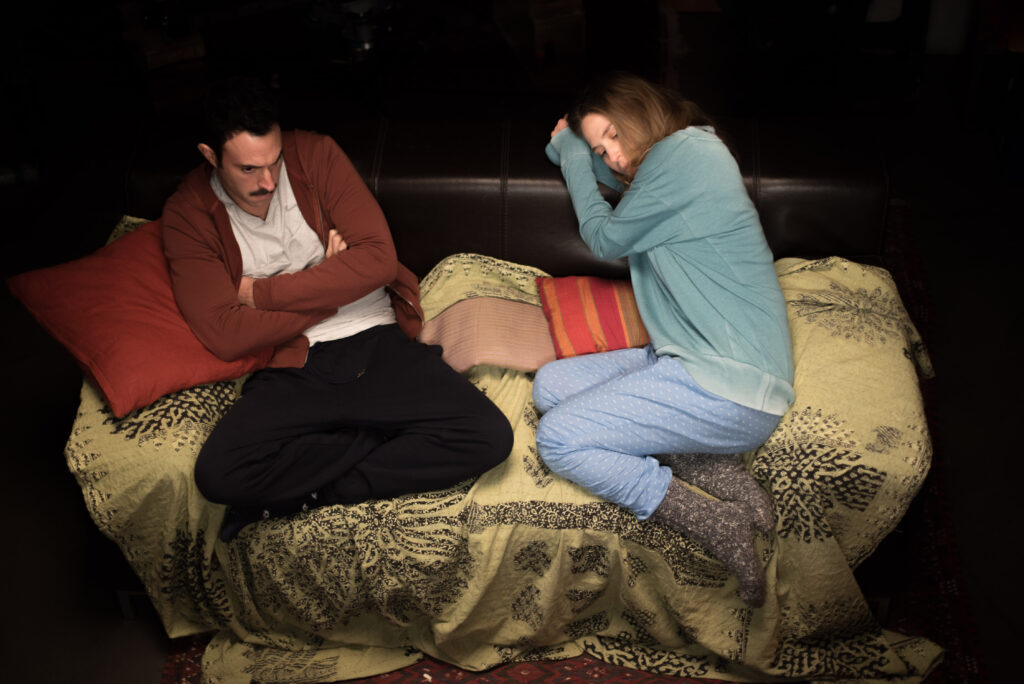
That which provides the attraction mechanism in the audience is to find how things really went, spying on the couple’s private reactions while on their own rediscovery. But since lies are always more intriguing than truth, Paolo becomes the real protagonist of this story. In fact, the audience knows a lot more about Paolo than Lucia does, a character that seems far too functional, if not just the litmus test of her partner’s behaviour. Alessio Vassallo manages to put on stage a good degree of measure even in the most desperate moments, such as when he attempts suicide. ( we give credits to Alessio Vassallo for some moves taken in the most desperate moments like attempted suicide) A quality that Paolo shares with the other characters too, also thanks to the irony with which Tavarelli colours the whole film, moving between an excessive exuberance and a comic lightness.
“Indagine su una storia d’amore” di Gianluca Maria Tavarelli
Una coppia di attori decide di partecipare al programma televisivo Scheletri nell’armadio in cui sono chiamati a raccontare la loro storia d’amore senza filtri e senza segreti. L’idea di Lucia (Barbara Giordano) è quella di cercare di farsi conoscere dal pubblico sfruttando la presa di una trasmissione nazional-popolare che, ormai, sembra essere l’unico veicolo di popolarità mediatica insieme ai social. Paolo (Alessio Vassallo) è invece reticente all’idea di tirare fuori i propri numerosi scheletri nell’armadio ma si lascia convincere, sedotto dalle prospettive lavorative. Si giurano allora di raccontare solo la verità davanti alle telecamere anche se, da attori, possono un po’ rielaborarla per l’audience. Una disfatta annunciata.
Leggi tutto: “Indagine su una storia d’amore” di Gianluca Maria TavarelliGianluca Maria Tavarelli, anche autore del soggetto e sceneggiatore, compie un’autopsia della relazione alla quale lo spettatore assiste con gusto voyeuristico. Dall’inizio del film, infatti, sappiamo già come andrà a finire la storia di Paolo e Lucia, ma veniamo catturati da una specie di morbosa curiosità su cui fanno leva la sceneggiatura e la messa in scena. Ci vengono mostrati e raccontati fatti puntualmente smentiti l’attimo successivo, tutto è messo in discussione e lo spettatore non sa più a chi credere. Così facendo, Tavarelli, con una narrazione multi-strato e multi-senso, mantiene costantemente acceso l’interesse del pubblico in sala che non ha il tempo di rilassarsi – o peggio – annoiarsi. Si salva così dal rischio di apparire banale nell’affrontare una tematica e un argomento divenuti quotidiani nell’epoca dell’iper-esposizione.

E scoprire come sono andate veramente le cose spiando le private reazioni della coppia alla propria ri-scoperta resta ciò che innesca il meccanismo di attrazione spettatoriale. Essendo però la menzogna da sempre più intrigante della verità, il vero protagonista della vicenda diventa Paolo. Lo spettatore conosce infatti molti più lati di Paolo che non di Lucia, personaggio che appare fin troppo funzionale quando non semplice cartina di tornasole del comportamento del compagno. Ad Alessio Vassallo il merito di una certa misura anche nei momenti più disperati come quello del tentato suicidio. Un tono che Paolo condivide anche con gli altri personaggi anche grazie all’ironia di cui Tavarelli colora tutto il film in bilico tra eccessiva esuberanza e comica leggerezza.
Carlotta Pegollo
“AUGURE (OMEN)” BY BALOJI
Article by Federico Lionetti
Translation by Martina Agostino
The young protagonist (Marc Zinga) and his pregnant girlfriend (Lucy Debay) fly from Belgium to Congo to reestablish their relationship with his family. However, he has to face the prejudice caused by a birthmark on his face – a bad omen, according to the local tradition, which has negatively affected his life since he was a child.
This is the very beginning of Augure, the opening film of the “Crazies” section of the 41st Turin Film Festival, and the first feature film by the eclectic artist Baloji, a Belgian graphic designer and musician from Congo. During the scenes of this family drama, the director tackles the spectacularity of the human bodies of a small local group, thereby depicting the colors and customs of a culture somewhere between actual African tradition and the director’s phantasmagorical inventiveness. A visual staging that crosses the boundaries of the mundane, taking us toward the magic of the fairy tale and the anxiety of the unconscious.
Continua la lettura di “AUGURE (OMEN)” BY BALOJI“AUGURE (OMEN)” DI BALOJI
Il giovane protagonista (Marc Zinga) e la fidanzata incinta (Lucy Debay) volano dal Belgio in Congo per ristabilire i rapporti con la famiglia di lui, trovandosi però ad affrontare i pregiudizi causati da una voglia che il ragazzo ha sul volto – un cattivo presagio, secondo la tradizione locale, che ne ha negativamente influenzato la vita fin da quando era bambino. Da questo incipit si muove la storia di Augure, film d’apertura della sezione “Crazies” della 41° edizione del Torino Film Festival, e primo lungometraggio dell’eclettico artista Baloji, grafico e musicista belga di origini congolesi. Sulla scena di un dramma familiare, il regista imbastisce la spettacolarità dei corpi umani di un piccolo gruppo locale, rappresentando in questo modo i colori e i costumi di una cultura a metà tra l’effettiva tradizione africana e l’inventiva fantasmagorica del regista. Un allestimento visivo che valica i confini del mondano, portandoci verso la magia della fiaba e l’inquietudine dell’inconscio.
Continua la lettura di “AUGURE (OMEN)” DI BALOJI“Gianni Versace: l’imperatore dei sogni” by Mimmo Calopresti
Article by Elisa Gnani
Translation by Giorgia Legrottaglie
«What are you doing? Are you sleeping at this time? No. I’m dreaming.».
If we could see with a painter’s eye Mimmo Calopresti’s portrait of one of Italy’s most beloved and most brilliant designers, it would appear to us as a chiaroscuro. This docu-fiction alternates between reality and fiction, past and present, the protagonist’s extensive cultural background and the abandonment of his studies. A duality that converges, in the end, in the construction of a great character, a down-to-earth dreamer: “I live in a dream. My dream is coming true: to be Gianni
Versace.”
“Gianni Versace: l’imperatore dei sogni” di Mimmo Calopresti
«Ma che fai, dormi a quest’ora? No. Sogno».
Se potessimo vedere con l’occhio di un pittore il ritratto che Mimmo Calopresti realizza di uno degli stilisti italiani più amati e più geniali, esso ci apparirebbe come un chiaroscuro. Un docu-fiction che alterna la realtà e la finzione, il passato e il presente, l’ampio bagaglio culturale del protagonista e l’abbandono degli studi. Una dualità che converge, in fondo, nella costruzione di grande personaggio, un sognatore con i piedi per terra: «Io vivo in un sogno. Il mio sogno si sta realizzando: essere Gianni Versace».
Continua la lettura di “Gianni Versace: l’imperatore dei sogni” di Mimmo Calopresti“Soleils Atikamekw” by Chloé Leriche
Article by Giorgia Andrea Bergamasco
Translation by Chiara Rotondo
The second feature film by Quebecois director Chloé Leriche, Soleils Atikamekw (Atikamekw Suns) portrays the profound intergenerational pain of the Atikamekw community in Manawan, Quebec. The film’s delicate aesthetics and careful formal work are not intended to sugarcoat the film, but rather to testify the strength and beauty of a community that, though destroyed, attempts to rebuild its memory.
Continua la lettura di “Soleils Atikamekw” by Chloé Leriche“SOLEILS ATIKAMEKW” DI CHLOÉ LERICHE
Secondo lungometraggio della regista quebecchese Chloé Leriche, Soleils Atikamekw ritrae il profondo dolore intergenerazionale della comunità Atikamekw di Manawan, Québec. La delicatezza estetica e l’accurato lavoro formale del film non sono volti a indorare la pillola, bensì a testimoniare la forza e la bellezza di una comunità che, seppur distrutta, tenta di ricostruire la propria memoria.
Continua la lettura di “SOLEILS ATIKAMEKW” DI CHLOÉ LERICHE“LE RAVISSEMENT” BY IRIS KALTENBACK
Article by Romeo Gjokaj
Translation by Camilla Lippi
Lydia (Hafsia Herzi) and Salomé’s lives are intricately and specularly linked: if one of them is happy, the other one suffers and viceversa. Therefore, on the same day that Salomé celebrates her birthday and her newly discovered pregnancy, Lydia mourns the end of her relationship with her boyfriend, letting herself go to a lonely and alienated autumnal Paris that resembles Taxi Driver’s (1976) New York. However, when Salomé gives birth, Lydia runs into Milos (Alexis Manenti) – an insomniac bus driver that impersonates De Niro’s Travis Bickle and with whom Lydia previously had a fling – and realizes that the newborn represents a desperate attempt for her to finally feel loved.
Continua la lettura di “LE RAVISSEMENT” BY IRIS KALTENBACK


